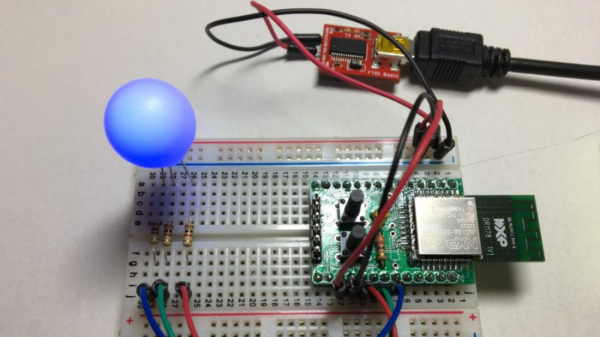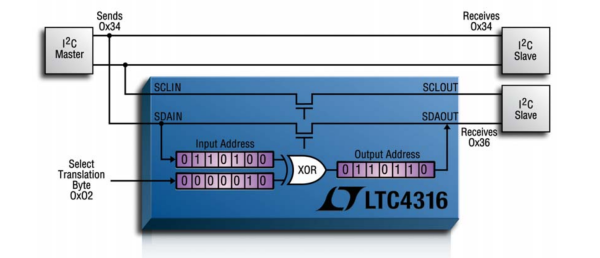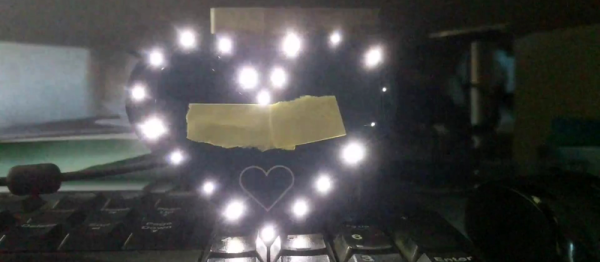Once upon a time, the automobile was a mostly mechanical beast, but no longer. Advanced electronics have weaved their way into the modern car, from engine to infotainment and climate control to the buttons now sprinkled throughout the passenger cabin. The gains in amenity and efficiency can’t be sniffed at, but it leaves manufacturers reliant on semiconductor suppliers to get cars out the door. Over the past year, it’s become much more complicated — with many automakers having to slow production in the face of integrated circuit shortages that can be traced back to Spring of 2020. Continue reading “Pandemic Chip Shortages Are Shutting Down Automotive Production”
nxp20 Articles
Hackaday Links: July 29, 2018
Another holy scroll for the Church of Robotron. PoC || GTFO is a semi-annual journal of hardware exploitation, and something you must read. About a year ago, No Starch Press released the first Bible of PoC || GTFO, and now it’s time for a new testament. PoC || GTFO Volume 2 is out now, covering Elegies of the Second Crypt War to Stones from the Ivory Tower, Only as Ballast. It’s still Bible-shaped, with a leatherette cover and gilt edges.
KiCad version 5 is out, and you know what that means: It’s time to start on version 6. To that end, CERN has opened up the floodgates where you, yes, you can donate to KiCad development. The team is looking for 600 hours of development and 30,000 Swiss Francs or about that many US Dollars. As of this writing (last Wednesday), more than 200 people have donated, at an average donation per person of about 80 CHF.
Oh good, this is finally over. Qualcomm will not be buying NXP. Previously, Reuters reported Qualcomm would purchase the other semiconductor manufacturer for $38 Billion, the largest semiconductor deal ever. There were earlier rumors of an acquisition. The deal was struck down by Chinese regulators, and speculation rages that this is a reaction to the US/China trade war. Qualcomm now has to pay NXP $2 Billion in fees, which they could use to dig out some of the unobtanium Motorola datasheets locked away in a file cabinet.
The uStepper (or μStepper, whatever) is a neat little add-on to standard NEMA stepper motors. It bolts to the back and gives you the ability to control a stepper over a standard serial bus, with a built-in encoder. Now there’s a new Kickstarter for an improved version that uses the Trinamic TMC2208 ‘silent’ motor driver. That Kickstarter is just a draft now, but if you’re planning a 3D printer build, this could be what you’re waiting for.
Hackaday Links: June 17, 2018
Do you like badges? Of course you like badges. It’s conference season, and that means it’s also badge season. Well good news, Tindie now has a ‘badge’ category. Right now, it’s loaded up with creepy Krustys, hypnotoads, and fat Pikas. There’s also an amazing @Spacehuhn chicken from [Dave]. Which reminds me: we need to talk about a thing, Spacehuhn.
On the list of ‘weird emails we get in the tip line’ comes Rat Grease. Rat Grease is the solution to rodents chewing up cabling and wires. From what we can gather, it’s a mineral oil-based gel loaded up with capsaicin; it’s not a poison, and not a glue. Rats are our friends, though, which makes me want to suggest this as a marinade, or at the very least a condiment. The flash point is sufficiently high that you might be able to use this in a fryer.
[Matthias Wandel] is the guy who can build anything with a table saw, including table saws. He posts his stuff online and does YouTube videos. A while back, he was approached by DeWalt to feature their tools in a few videos. He got a few hand tools, a battery-powered table saw, and made some videos. The Internet then went insane and [Matthias] lost money on the entire deal. Part of the reason for this is that his viewers stopped buying plans simply because he featured yellow power tools in his videos. This is dumpster elitism, and possibly the worst aspect of the DIY/engineering/maker community.
Elon Musk is the greatest inventor ever. No scratch that. The greatest person ever. Need more proof? The CEO of Tesla, SpaceX, and our hearts has been given the green light to build a high-speed underground train from Chicago O’Hare to downtown. Here’s the kicker: he’s going to do it for only $1 Billion, or $55 Million per mile, making it the least expensive subway project by an order of magnitude. Yes, Subways usually cost anywhere between $500 to $900 Million per mile. How is he doing it? Luck, skill, and concentrated power of will. Elon is the greatest human ever, and we’re not just saying that to align ourselves with an audience that is easy to manipulate; we’re also saying this because Elon has a foggy idea for a ‘media vetting wiki’.
There are rumors Qualcomm will acquire NXP for $44 Billion. This deal has been years in the making, with reports of an acquisition dating back to 2016. Of course, that time, the deal was set to go through but was apparently put on hold by Chinese regulators. Now it’s the same story again; there were recent rumors of Qualcomm buying NXP, and the story was later changed to rumors. We’re waiting for an actual press release on this one. It’s just another long chapter in the continuing story of, ‘where the hell are all the Motorola app notes and data sheets?’
A Modern, Upgraded BASIC Stamp
Back in the Before Times, when microcontroller development required ultraviolet light, building anything was a pain. You probably had to burn a ROM onto a chip with a parallel programmer, there was no in-circuit programming, and who knows what would happen if you needed a serial port.
This changed in the early 90s with the introduction of the BASIC Stamp from Parallax. This was a simple microcontroller development board using Microchip PIC. With a little bit of clever firmware developed by Parallax, you could write code in BASIC, upload your code over a serial or parallel port (which every computer had), and blink a LED with just a few lines of code. All microcontroller development boards — including the Arduino — owe a debt to the BASIC Stamp. It is the grandfather to the Arduino, and it is very, very old.
Microchip didn’t update the BASIC Stamp, but that doesn’t mean someone else can’t handle that. [Bruce Eisenhard] is crowdfunding an improved, updated version of the famous 24-pin BASIC Stamp. It’s got modern parts, runs seven hundred times faster than the original, and is still chock full of BASIC interpretation.
This upgraded Stamp is built around NXP’s LPC11U3 micrcontroller, an ARM Cortex-M0 part with about a hundred times more Flash than the chip in the original Stamp. Programming is done through modern IDEs, and yes, there’s a USB port. This project is pin-compatible with the original BASIC Stamp, so if your microcontroller project from twenty years ago is dying, this is the replacement for you.
The BASIC Stamp was an awesome device for its time, even though it cost more than two hundred dollars in today’s money. [Bruce]’s campaign is offering one of these for $25, which is pretty reasonable for what it is.
Create Cheap Philips Hue Compatible Devices
The Philips Hue range is a great way to add wirelessly controllable lighting to your home, but the protocol is proprietary which makes it difficult to add our own custom hardware. [Peter] found a way to create his own Hue compatible devices based on cheap JN5168 modules that are able to connect to the Hue bridge. This means you can roll out your own lamps using cheap RGB or White LEDs, a power supply and the JN5168 Zigbee Light Link module.
He started off by trying to clone a Zigbee Light Link device to a MeshBee — Seeed studio’s open source Zigbee Pro module based on the NXP JN5168. Even though the MeshBee used the same device as a Hue lamp, it would not connect to the Hue bridge. But another clone lamp called Innr that he purchased from the local hardware store did connect quite easily. Using NXP’s open source tools, he was able to download the flash and EEPROM contents from the Innr and copy them to the MeshBee which did the trick.
After the EEPROM transfer trick, he figured out how to modify the two keys used for the ZigBee protocol — one for Home Automation and the other for the Light Link. With this final discovery he is able to take the ZigBee Light Link demo project, edit it using Beyond Studio, and then load the binaries on the MeshBee device so it can connect to the Hue bridge.
All of this work culminates in two custom firmware binaries; one for white dimmable lights and another for RGB dimmable ones. It even runs on these cheap JN5168 breakout kits he found for a few bucks. With all of the software taken care of, and having cheap ZigBee Light Link compatible modules on hand, building low cost Hue compatible lights becomes pretty straight forward.
Thanks [wind-rider] for the tip.
LTC4316 Is The I2C Babelfish
The LTC4316 is something special. It’s an I²C address translator that changes the address of a device that would otherwise conflict with another on the same I²C bus. Not a hack? Not so fast. Exactly how this chip does this trick is clever enough that I couldn’t resist giving it the post it rightfully deserves.
On-the-Fly Translation
What’s so special? This chip translates the address on-the-fly, making it transparent to the I²C protocol. Up until this point, our best bet for resolving address collisions was to put the clashing chip on a separate I²C bus that could be selectively enabled or disabled. In that department, there’s the PCA9543 and PCA9547 demultiplexers which we’ve seen before. Both of these devices essentially act like one-way check valves. To address any devices downstream, we must first address the multiplexer and select the corresponding bus. While these chips resolve our address collision problems, and while there’s technically a way to address a very large number of devices if we’re not time-constrained, the control logic needed to address various bus depths can get clunky for nested demultiplexers.
What’s so classy about the LTC4316 is that is preservers simplicity by keeping all devices on the same bus. It prevents us from having to write a complicated software routine to address various sections of a demultiplexed I²C bus. In a nutshell, by being protocol-transparent, the LTC4316 keeps our I²C master’s control logic simple.
How it Works
I mocked up a quick test setup to have a go at this chip in real life. Continue reading “LTC4316 Is The I2C Babelfish”
Valentine’s Heart With Awesome Animations
January has drawn to a close, and for many of you that means: “Oh no! Less than two weeks’ time until Valentine’s day.” But for us here at Hackaday, it means heart-themed blinky projects. Hooray!
[Dmitry Grinberg] has weighed in with his version of the classic heart-shaped LED ring. It’s hard to beat the BOM on this one: just a microcontroller, five resistors, and twenty LEDs. The rest is code, and optionally putting the name of your beloved into the copper layer. Everything is there for you to download.
Continue reading “Valentine’s Heart With Awesome Animations”















